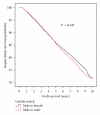H-Y Antigen Incompatibility Not Associated with Adverse Immunologic Graft Outcomes: Deceased Donor Pair Analysis of the OPTN Database
- PMID: 22013503
- PMCID: PMC3195447
- DOI: 10.1155/2011/148457
H-Y Antigen Incompatibility Not Associated with Adverse Immunologic Graft Outcomes: Deceased Donor Pair Analysis of the OPTN Database
Abstract
Background. H-Y antigen incompatibility adversely impacts bone marrow transplants however, the relevance of these antigens in kidney transplantation is uncertain. Three previous retrospective studies of kidney transplant databases have produced conflicting results. Methods. This study analyzed the Organ Procurement and Transplantation Network database between 1997 and 2009 using male deceased donor kidney transplant pairs in which the recipient genders were discordant. Death censored graft survival at six months, five, and ten years, treated acute rejection at six months and one year, and rates of graft failure by cause were the primary endpoints analyzed. Results. Death censored graft survival at six months was significantly worse for female recipients. Analysis of the causes of graft failure at six months revealed that the difference in death censored graft survival was due primarily to nonimmunologic graft failures. The adjusted and unadjusted death censored graft survivals at five and ten years were similar between the two genders as were the rates of immunologic graft failure. No difference in the rates of treated acute rejection at six months and one year was seen between the two genders. Conclusions. Male donor to female recipient discordance had no discernable effect on immunologically mediated kidney graft outcomes in the era of modern immunosuppression.
Figures


Similar articles
-
Living Donor Kidney Transplantation Improves Graft and Recipient Survival in Patients with Multiple Kidney Transplants.J Clin Med. 2020 Jul 5;9(7):2118. doi: 10.3390/jcm9072118. J Clin Med. 2020. PMID: 32635614 Free PMC article.
-
Outcomes of renal transplantation for recipients with lupus nephritis: analysis of the Organ Procurement and Transplantation Network database.Transplantation. 2006 Sep 15;82(5):612-8. doi: 10.1097/01.tp.0000235740.56573.c6. Transplantation. 2006. PMID: 16969282
-
Association of Deceased Donor Acute Kidney Injury With Recipient Graft Survival.JAMA Netw Open. 2020 Jan 3;3(1):e1918634. doi: 10.1001/jamanetworkopen.2019.18634. JAMA Netw Open. 2020. PMID: 31913491 Free PMC article.
-
Validating Early Post-Transplant Outcomes Reported for Recipients of Deceased Donor Kidney Transplants.Clin J Am Soc Nephrol. 2016 Feb 5;11(2):324-31. doi: 10.2215/CJN.06950615. Epub 2015 Dec 14. Clin J Am Soc Nephrol. 2016. PMID: 26668026 Free PMC article.
-
Outcomes From Right Versus Left Deceased-Donor Kidney Transplants: A US National Cohort Study.Am J Kidney Dis. 2020 May;75(5):725-735. doi: 10.1053/j.ajkd.2019.08.018. Epub 2019 Dec 5. Am J Kidney Dis. 2020. PMID: 31812448 Free PMC article.
Cited by
-
The Role of Donor Sex in Females Undergoing Repeat Kidney Transplant: Does Prior Donor Sex Matter?Transplant Direct. 2022 Jul 15;8(8):e1352. doi: 10.1097/TXD.0000000000001352. eCollection 2022 Aug. Transplant Direct. 2022. PMID: 37077730 Free PMC article.
-
Identification of patients at risk for renal impairment after living donor kidney transplantation.Langenbecks Arch Surg. 2016 Dec;401(8):1219-1229. doi: 10.1007/s00423-016-1492-2. Epub 2016 Aug 9. Langenbecks Arch Surg. 2016. PMID: 27502290
-
Sex matching does not impact the outcome after simultaneous pancreas-kidney transplantation.Clin Transplant. 2019 Nov;33(11):e13717. doi: 10.1111/ctr.13717. Epub 2019 Oct 4. Clin Transplant. 2019. PMID: 31545525 Free PMC article.
-
Clinical impact of H-Y alloimmunity.Immunol Res. 2014 May;58(2-3):249-58. doi: 10.1007/s12026-014-8514-3. Immunol Res. 2014. PMID: 24781195 Free PMC article. Review.
References
-
- Scott DM, Ehrmann IE, Ellis PS, Chandler PR, Simpson E. Why do some females reject males? The molecular basis for male-specific graft rejection. Journal of Molecular Medicine. 1997;75(2):103–114. - PubMed
-
- Warren EH, Gavin MA, Simpson E, et al. The human UTY gene encodes a novel HLA-B8-restricted H-Y antigen. Journal of Immunology. 2000;164(5):2807–2814. - PubMed
-
- Vogt MHJ, van den Muijsenberg JW, Goulmy E, et al. The DBY gene codes for an HLA-DQ5-restricted human male-specific minor histocompatibility antigen involved in graft-versus-host disease. Blood. 2002;99(8):3027–3032. - PubMed
-
- Millrain M, Scott D, Addey C, et al. Identification of the immunodominant HY H2-Dk epitope and evaluation of the role of direct and indirect antigen presentation in HY responses. Journal of Immunology. 2005;175(11):7209–7217. - PubMed
LinkOut - more resources
Full Text Sources

